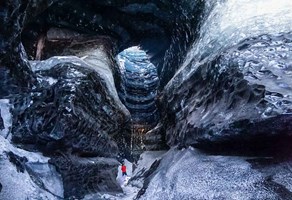Réttir - Sheep Round Up

The Icelandic sheep has always played a big role in the Icelandic life and culture. One could say that the sheep kept the Icelandic people alive for centuries, because the sheep was the main food in Iceland back in the days and people literally ate every single part it. They made smoked lamb from the thigh, slaughter (slátur) from the innards, they also made whey-pickled foods (súrmatur) from the meet and singed the sheep legs and head (svið).

Back in the days the sheep was milked during spring and summer, after the lambs were born. Then the lamb was taken away from them, and the sheep was kept in the mountains were the teenagers of the farm took care of them, milked them and brought the milk home to the farm. Back at the farm dairy products were made from the milk, such as butter and cheese. The wool was also very important, it kept people warm during the time when houses in Iceland were not heated. The wool provided good insulation and could even get wet without losing its insulation value.

There are around 500.000 sheep's in Iceland, most of them are in the North and South. The Icelandic lamb meat is still very popular in Iceland, although its consumption has decreased in recent years. Icelanders don’t have to rely on the wool today to keep them warm but it’s still very popular both among Icelanders and tourists. The wool sweater or Lopapeysa is very iconic for Iceland and you might say that you are not a true Icelander unless you own at least one wool sweater.
Sheep Round Up
Every spring the sheep's go to the mountains were they enjoy the nature during the summer and during the autumn the farmers go to the mountains to collect their sheep's. Usually several farmers and their people go together to collect them down from the mountains. It can take from one day to a whole week to collect them all. There is usually one “mountain king”, he controls and organizes the sheep gathering, each individual gets a certain area to search for sheep's and it’s very important that everyone works together so that no sheep gets away and no one gets left behind. It can be hard as the landscape can be difficult with steep mountains and narrow gorge.
Sometimes the Icelandic horse is used to gather the sheep's in the mountains. The horse is used to the Icelandic nature, he also has good temperament and great endurance and thus good to help out with the sheep gathering.

When the sheep gathering takes more than one day people sleep in mountain huts. Everyone gathers at the mountain huts in the evening (also the sheep's that were found during the day) and the horses rest and gather strength for the next day. The people usually have some fun together singing and sometimes enjoy one or two shots of the Icelandic schnapps called Brennivín to ensure a good night’s sleep. Before the mountain huts people had to stay in small caves, they slept in the caves with the sheep to keep them warm on cold autumn nights. These caves still exist today and they remind us of how hard the life could be back in the old days.

On the last day all the sheep's are rounded up in one place called Réttir. The farmers can identify their livestock by an earmark and each farmer has their own stall. Once all the sheep and the lambs have been assembled they are sorted into designated stall, according to their earmarks. There is often a lot of fun and joy during that day, it usually involves some drinking, dancing and singing which is usually followed by a big celebration the same night.
Want to join?
Réttir in Iceland is a unique experience and if you are traveling in Iceland in September you should check it out. You can find Réttir all over Iceland, check out the nearest information center for more information.







